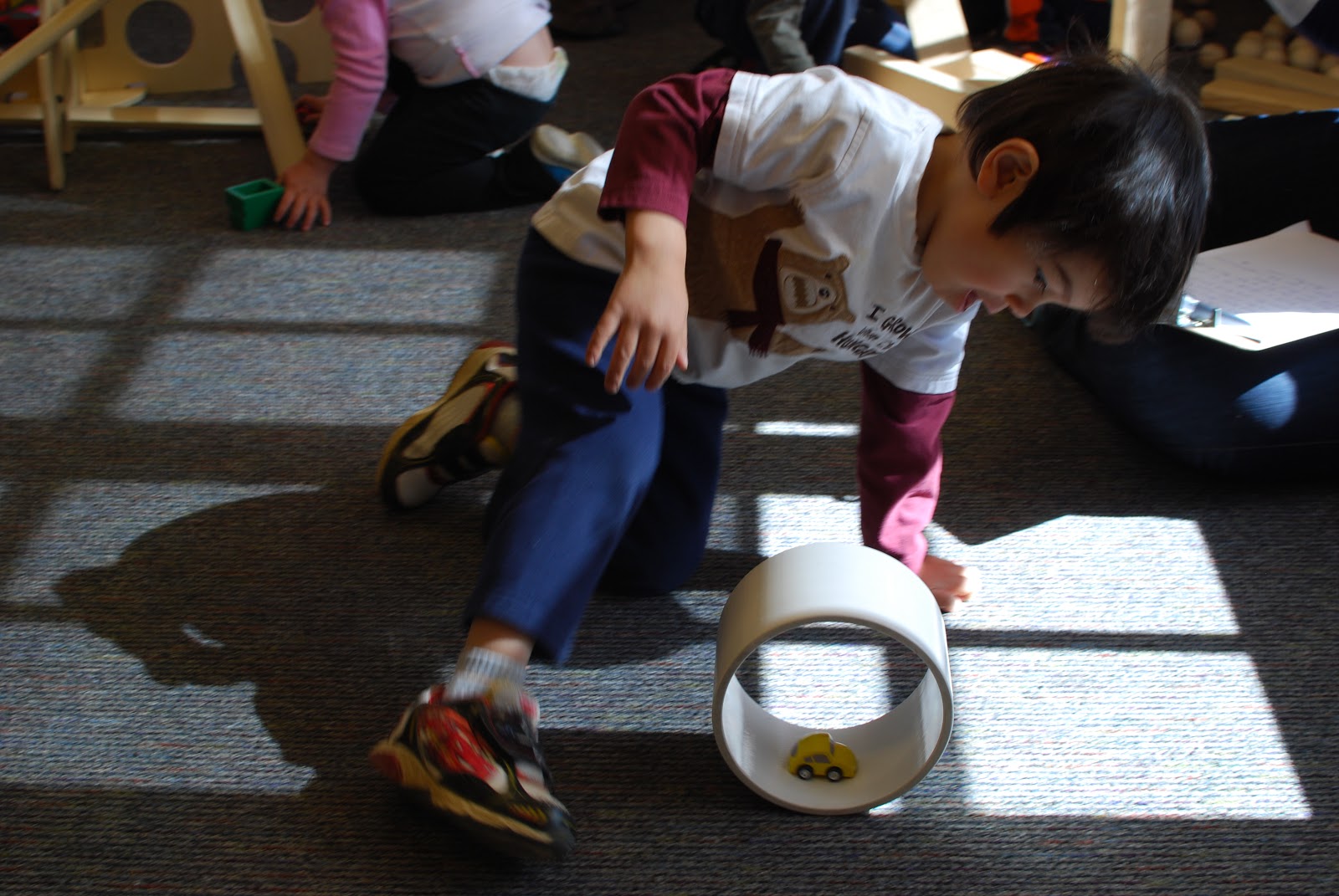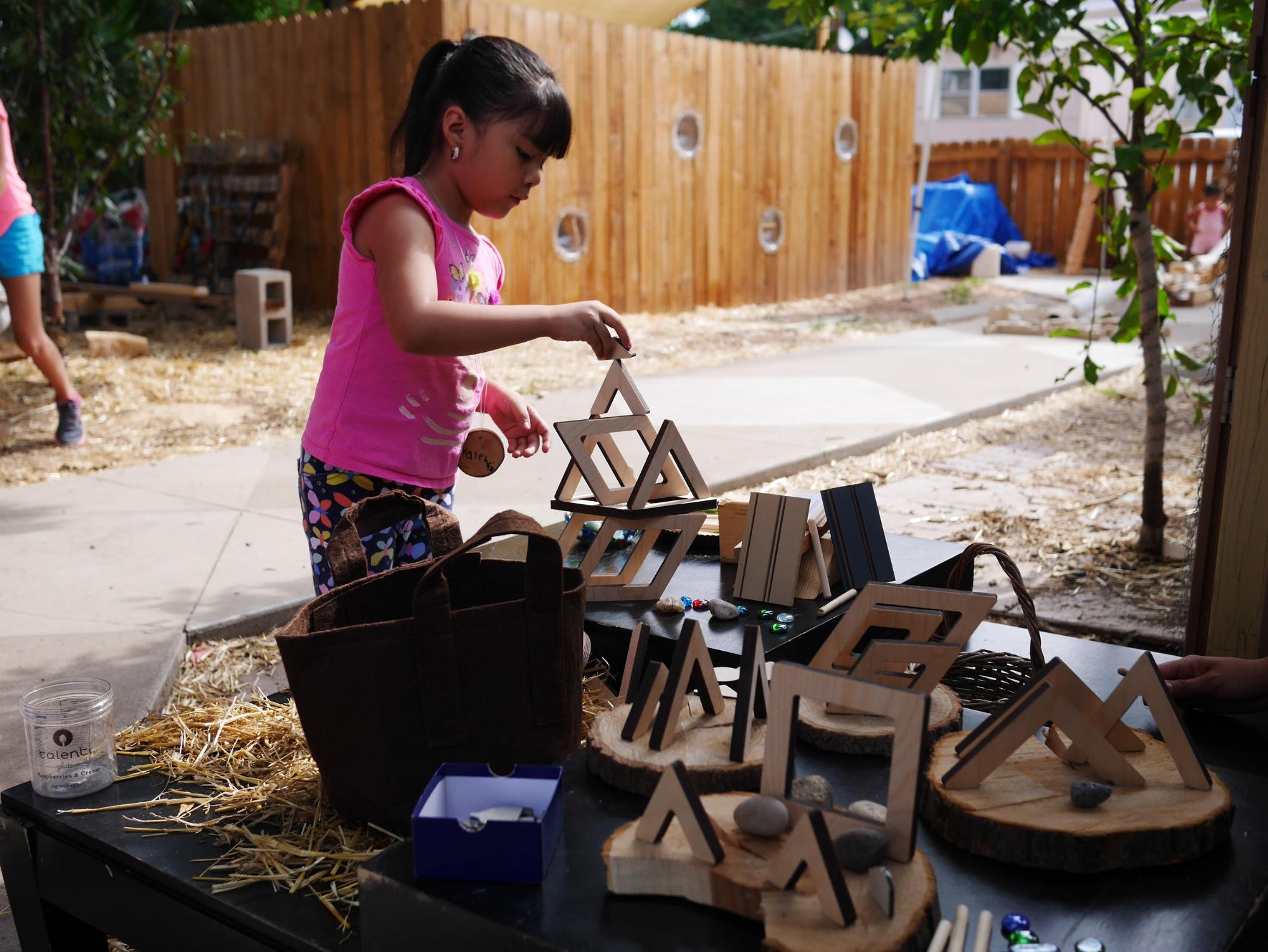At Kodo we’re big fans of plenty of time for unstructured play, due to the many benefits for both children and teachers. It occurs daily in most, if not all, preschool programs here in the US. You might know it as, Free Choice Time, Free Play, or Children’s Choice, to name a few ways ECE educators designate it within their daily schedules. (There certainly are a number of schools and programs out there in which this free choice comprises the bulk of the day and if you’re in one of those programs, we salute you!) I also want to note that in the Kodo Classroom we do agree there is a time and place for formal instruction and group meetings, but we’ve come to regard unstructured play time as a valuable tool in which adults can make authentic observations and uncover children’s interests, knowledge, and challenges they are facing. These findings are then used to: give instruction when needed, develop topics for meaningful discussions during classroom meetings, plan events and develop learning environments within the school and classroom, assess children’s strengths, and develop future goals for them within the context of the classroom community and it’s overarching needs and interests. What we’re talking about are the endless possibilities that free, unstructured play offers not only the child, but also the educator. So in this next series of posts, we’ll look at a few of the countless examples we’ve seen firsthand and heard tell of from many of you. Our focus will be twofold; uncovering the learning within children’s play and utilizing this time as a tool for the educator.
First in the series - Anders makes a discovery about motion and momentum during unstructured play.
While tinkering about during free play time, Anders experiments with things that roll. He began his play by researching and categorizing things he knew had the ability to be rolled. We, adults, watched as he began to place things that rolled into a pile. (In this photo you can detect the teacher sitting just behind Anders with her clipboard full of observational notes.)
He used self-talk as he played and we overheard some snippets of his metacognitive dialog. “I know blocks won’t do it (roll), but cars do”. Then later, “...that (rolling) happened before with the big tube, it goes and goes and goes if I push it harder”. As Anders played, he experimented. He placed a small toy car, which he knew rolled, inside of a large tube, which he also knew could roll. His connection between two materials which had a similar property was made, in part, by his freedom to combine and use items in the way he wished. His acts of sorting materials and calling on known information also enabled him to make a leap and combine the car with the tube. We think Anders’ research questions may have been similar to, “Will the tube and the car roll together”, and “what ways will the car move inside the tube, if any?” What do you think he may have been asking?
Photo description: Anders’ at play with objects that have a common property - their ability to roll. Look at how focused he is!!


More Q.’s for early childhood educators and parents. What do you think Anders was thinking? What kinds of questions would you form to help Anders deepen and broaden his learning? If this were to have occurred in your classroom, in what ways would you record Anders’ learning, make it visible to other children and adults, and build on it?
Identifying the physics here might take a little research on the part of the adult. Rotational Kinetic Energy isn’t something we’d ever “teach” young children, yet here it is in action in a preschool classroom. Whether or not adults recognize and/or understand the physics certainly isn’t necessary to formulate age-appropriate questions for children, but knowing something about it can’t hurt! When the teacher eventually asked Anders why he thought his car stayed inside the tube as it rolled, he paused, thought for a moment, and then answered, “Because wheels roll.” “But why didn’t the car roll out”, prodded the teacher. Anders didn’t answer, nor was expected to give an answer. The question was an open-ended, intentional prompt, and by posing it, the teacher helped fuel a deeper investigation. the question invited Anders to think about physics in a developmentally appropriate way.

Certainly we are not suggesting that each and every one of your children’s discoveries can or should be approached like this; photographed, documented, or researched. Nor are we implying that every discovery will launch an investigation, drive the curriculum, or that educators have time to research and plan for such. We know from experience that it would be virtually impossible for an adult to follow every child through every minute of their play. But just because we don’t capture all the moments, witness first hand all the wonder, or formulate myriad open-ended questions on the spot, doesn’t mean that children aren’t learning. In fact just the opposite is true! It’s doubtful any early childhood teacher would intentionally set out to plan a lesson on Rotational Kinetic Energy! The teachers in this classroom didn’t, but were thrilled when the open-ended loose parts coupled with a child’s curiosity yielded this intriguing play.
When children engage in free and unstructured play, learning occurs naturally, uninhibited by the limitations of what we think a material is supposed to ‘teach’. Anders’ play with kinetic energy inspired another child to experiment with motion. Then the two young researchers met on their own to compare their discoveries. Wow - talk about the value of Free Play!
Want to inspire your own discoveries on motion and momentum? Check out our
tube kit to bring the experience to your classroom!

 More Q.’s for early childhood educators and parents. What do you think Anders was thinking? What kinds of questions would you form to help Anders deepen and broaden his learning? If this were to have occurred in your classroom, in what ways would you record Anders’ learning, make it visible to other children and adults, and build on it?
Identifying the physics here might take a little research on the part of the adult. Rotational Kinetic Energy isn’t something we’d ever “teach” young children, yet here it is in action in a preschool classroom. Whether or not adults recognize and/or understand the physics certainly isn’t necessary to formulate age-appropriate questions for children, but knowing something about it can’t hurt! When the teacher eventually asked Anders why he thought his car stayed inside the tube as it rolled, he paused, thought for a moment, and then answered, “Because wheels roll.” “But why didn’t the car roll out”, prodded the teacher. Anders didn’t answer, nor was expected to give an answer. The question was an open-ended, intentional prompt, and by posing it, the teacher helped fuel a deeper investigation. the question invited Anders to think about physics in a developmentally appropriate way.
More Q.’s for early childhood educators and parents. What do you think Anders was thinking? What kinds of questions would you form to help Anders deepen and broaden his learning? If this were to have occurred in your classroom, in what ways would you record Anders’ learning, make it visible to other children and adults, and build on it?
Identifying the physics here might take a little research on the part of the adult. Rotational Kinetic Energy isn’t something we’d ever “teach” young children, yet here it is in action in a preschool classroom. Whether or not adults recognize and/or understand the physics certainly isn’t necessary to formulate age-appropriate questions for children, but knowing something about it can’t hurt! When the teacher eventually asked Anders why he thought his car stayed inside the tube as it rolled, he paused, thought for a moment, and then answered, “Because wheels roll.” “But why didn’t the car roll out”, prodded the teacher. Anders didn’t answer, nor was expected to give an answer. The question was an open-ended, intentional prompt, and by posing it, the teacher helped fuel a deeper investigation. the question invited Anders to think about physics in a developmentally appropriate way.
 Certainly we are not suggesting that each and every one of your children’s discoveries can or should be approached like this; photographed, documented, or researched. Nor are we implying that every discovery will launch an investigation, drive the curriculum, or that educators have time to research and plan for such. We know from experience that it would be virtually impossible for an adult to follow every child through every minute of their play. But just because we don’t capture all the moments, witness first hand all the wonder, or formulate myriad open-ended questions on the spot, doesn’t mean that children aren’t learning. In fact just the opposite is true! It’s doubtful any early childhood teacher would intentionally set out to plan a lesson on Rotational Kinetic Energy! The teachers in this classroom didn’t, but were thrilled when the open-ended loose parts coupled with a child’s curiosity yielded this intriguing play.
When children engage in free and unstructured play, learning occurs naturally, uninhibited by the limitations of what we think a material is supposed to ‘teach’. Anders’ play with kinetic energy inspired another child to experiment with motion. Then the two young researchers met on their own to compare their discoveries. Wow - talk about the value of Free Play!
Want to inspire your own discoveries on motion and momentum? Check out our tube kit to bring the experience to your classroom!
Certainly we are not suggesting that each and every one of your children’s discoveries can or should be approached like this; photographed, documented, or researched. Nor are we implying that every discovery will launch an investigation, drive the curriculum, or that educators have time to research and plan for such. We know from experience that it would be virtually impossible for an adult to follow every child through every minute of their play. But just because we don’t capture all the moments, witness first hand all the wonder, or formulate myriad open-ended questions on the spot, doesn’t mean that children aren’t learning. In fact just the opposite is true! It’s doubtful any early childhood teacher would intentionally set out to plan a lesson on Rotational Kinetic Energy! The teachers in this classroom didn’t, but were thrilled when the open-ended loose parts coupled with a child’s curiosity yielded this intriguing play.
When children engage in free and unstructured play, learning occurs naturally, uninhibited by the limitations of what we think a material is supposed to ‘teach’. Anders’ play with kinetic energy inspired another child to experiment with motion. Then the two young researchers met on their own to compare their discoveries. Wow - talk about the value of Free Play!
Want to inspire your own discoveries on motion and momentum? Check out our tube kit to bring the experience to your classroom!






Share:
Where does food come from? An Investigation Inspiration
Inquiry Approach to Teaching : Introducing Constraints